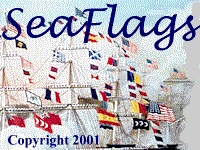
 |
Department of State and Foreign Service Flags |
On this page:
Return to Sea Flags home pageSimilar flags are authorized by State Department regulations for the
Deputy Secretary and Under Secretaries of State. That for the Deputy,
which is white with the arms on a blue disk and four blue stars, was originally
established as the Under Secretary's flag by the same 1933 order that promulgated
the current design of the Secretary's flag. It was inherited by the
Deputy Secretary when that position was created to supersede the Under
Secretary as the number two official in the Department of State in 1973.
Simultaneously, a new flag was created for the Under Secretaries--who now
ranked after the Deputy--with a red field and white disk and stars.
Neither of these flags is authorized for use by the Navy.
| Under current Navy regulations, an ambassador's presence in a boat of the Navy within the waters of the country to which he or she is accredited, is signified by flying the union jack at the bow staff, topped with a spread eagle finial. In 1946, the State Department provided for the same flag's display on automobiles carrying chiefs of diplomatic missions, including ambassadors. | |
| The Department of State's Foreign Affairs Manual (2 FAM 153.2), however, now provides this distinctive personal flag for ambassadors and other chiefs of mission accredited to sovereign states, similar to that of the Secretary of State but with the disk bearing the coat of arms surrounded by a ring of 13 white stars. The proportions are 10:19, as for the national flag. Given the status of ambassadors as the President's personal representatives in the countries to which each is accredited, it would not be surprising for this flag to be given official recognition in the future for use in Navy boats, particularly since the consular officers who work for the ambassador have long had a distinctive flag for similar use. |
|
Chiefs of diplomatic missions accredited to other than sovereign states
(such as the U.S. Permanent Representative to the United Nations or the
U.S. ambassadors to NATO or the European Union) fly a similar flag but
with the arms directly on a white field and the ring of stars in dark blue.
As these organizations do not have "territorial waters," there would be
no basis for using this flag in the Navy.
Return to top of page
This flag was adopted
by the Department of State in 1903 to indicate the presence of an American
consular officer aboard a boat in foreign waters. The same use aboard
boats of the Navy was approved in 1909. A version in 10:19 proportions
with a gold fringe, cord, and tassels, has since been established for display
in specified locations at American consulates abroad. It can also
be used as an automobile flag by the principal officer of a consular post.
Sea
Flags
Copyright 2000, 2001 by Joseph McMillan